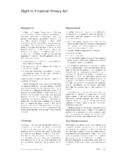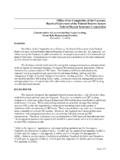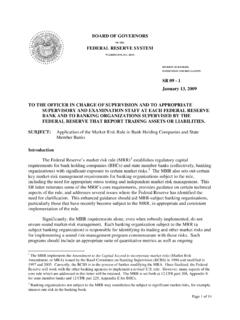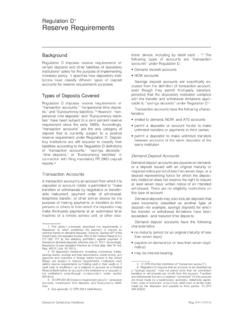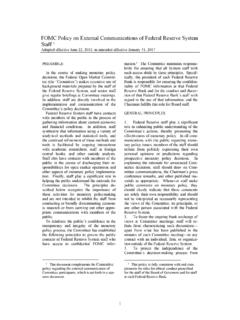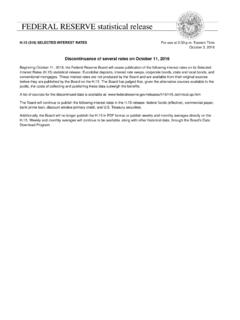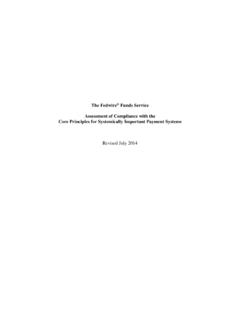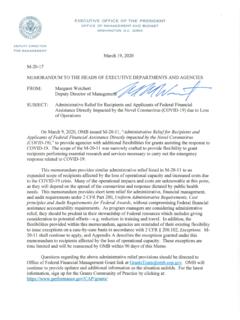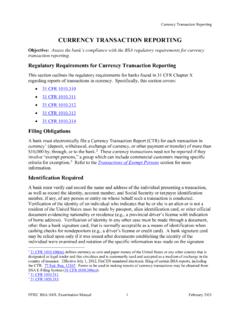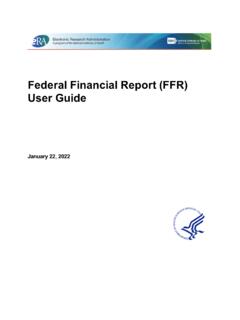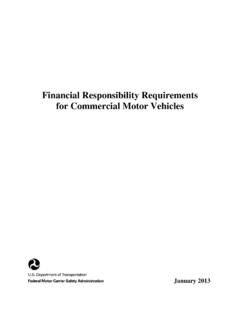Transcription of Financial Literacy: An Overview of ... - Federal Reserve
1 Financial Literacy: An Overview of Practice, Research, and Policy Sandra Braunstein and Carolyn Welch, of the Board's Division of Consumer and Community Affairs, pre-pared this article. In recent years, Financial literacy has gained the atten-tion of a wide range of major banking companies, government agencies, grass-roots consumer and com-munity interest groups, and other organizations. Inter-ested groups, including policymakers, are concerned that consumers lack a working knowledge of finan-cial concepts and do not have the tools they need to make decisions most advantageous to their economic well-being.
2 Such Financial literacy deficiencies can affect an individual's or family's day-to-day money management and ability to save for long-term goals such as buying a home, seeking higher education, or financing retirement. Ineffective money management can also result in behaviors that make consumers vulnerable to severe Financial crises. From a broader perspective, market operations and competitive forces are compromised when consum-ers do not have the skills to manage their finances effectively. Informed participants help create a more competitive, more efficient market.
3 As knowledge-able consumers demand products that meet their short- and long-term Financial needs, providers com-pete to create products having the characteristics that best respond to those demands. As concern about Financial literacy has increased, so too have the number and variety of Financial literacy training programs and program providers some offering comprehensive information on sav-ings, credit, and similar topics for a broad audience and others tailored to a specific group, such as youth or military personnel, or focused on a specific goal, such as home ownership or savings.
4 The findings of studies of the effectiveness of Financial literacy training have been mixed. Although some programs, particularly those having discrete objectives, have succeeded in improving certain aspects of consumers' personal Financial management such as maintaining a mortgage, increasing savings, or participating in employer-sponsored benefit plans improved Financial behav-ior does not necessarily follow from increased finan-cial information. The timing and format of training, as well as human traits such as aversion to change, play a role in whether programs will effect positive change that contributes to households' long-term Financial well-being.
5 Accounting for all the variables associated with Financial literacy training when, how, and where it is delivered, who is trained, and what information is presented poses a great challenge for program developers. Given the resources now devoted to Financial literacy training, this is an opportune time to evaluate the research, identify best practices, and consider public policy options that would further the goal of creating more financially savvy consumers. CHANGES PROMPTING INCREASED ATTENTION TO Financial LITERACY. Numerous factors have led to a complex, specialized Financial services marketplace that requires consum-ers to be actively engaged if they are to manage their finances effectively.
6 The forces of technology and market innovation, driven by increased competition, have resulted in a sophisticated industry in which consumers are offered a broad spectrum of services by a wide array of providers. Compelling consumer issues, such as the very visible issue of predatory lending, high levels of consumer debt, and low sav-ing rates, have also added to the sense of urgency surrounding Financial literacy. Other important demo-graphic and market trends contributing to concerns include increased diversity of the population, result-ing in households that may face language, cultural, or other barriers to establishing a banking relationship; expanded access to credit for younger populations; and increased employee responsibility for directing their own investments in employer-sponsored retire-ment and pension plans.
7 Technological Changes and Market Innovation. Over the past decade, technological advances have transformed nearly every aspect of the marketing, delivery, and processing of Financial products and services. The expansion of the Internet as a means of communicating and delivering services has also enabled Financial services providers to market finan-cial products and serve customers more efficiently. Communication and delivery innovations increase the amount of information available to consumers and allow them to shop for and choose from a wide array of products and services without geographic limitation.
8 To benefit from the innovations, however, consumers need a base level of Financial knowledge, so that they can identify and access pertinent informa-tion as well as evaluate the credibility of the source of the information. Technological advances have also increased the capacity for targeted marketing to consumers, with robust databases of consumer information making it possible to match household characteristics and pref-erences with product offerings. This application of technology can promote competition and improve customer service. However, its misuse can increase consumer vulnerability to unscrupulous lenders.
9 Questionable marketing and sales tactics may induce consumers to acquire products that they do not need or that are inappropriate for their circumstances. In addition to broadening the application of data-bases in marketing, technology has enabled the use of databases in loan underwriting. Using statistical mod-eling, sophisticated computer programs produce a numerically based risk profile of consumers to estab-lish a range of acceptable risk and to develop guide-lines for pricing credit. While credit-scoring tech-nology has increased loan production and decreased creditor costs, it has also diminished lender-customer interaction.
10 With the lack of personal involve-ment, consumers, particularly those unfamiliar with banking and credit systems, have limited means for obtaining insight on the elements in their finan-cial profile that affect decisionmaking and guidance on the course of action necessary to improve their creditworthiness. Market innovation and competition within the Financial services industry can also be seen in the increase in the variety of products offered by deposi-tory institutions. For example, basic deposit and credit products have multiplied and become highly specialized.
